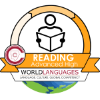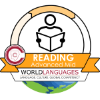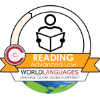At the Advanced level, readers can understand the main idea and supporting details of authentic narrative and descriptive texts. Readers are able to compensate for limitations in their lexical and structural knowledge by using contextual clues. Comprehension is likewise supported by knowledge of the conventions of the language (e.g., noun/adjective agreement, verb placement, etc.). When familiar with the subject matter, Advanced-level readers are also able to derive some meaning from straightforward argumentative texts (e.g., recognizing the main argument).
Advanced-level readers are able to understand texts that have a clear and predictable structure. For the most part, the prose is uncomplicated and the subject matter pertains to real-world topics of general interest.
Advanced-level readers demonstrate an independence in their ability to read subject matter that is new to them. They have sufficient control of standard linguistic conventions to understand sequencing, time frames, and chronology. However, these readers are likely challenged by texts in which issues are treated abstractly.
 Advanced High
Advanced High
At the Advanced High sublevel, readers are able to understand, fully and with ease, conventional narrative and descriptive texts of any length as well as more complex factual material. They are able to follow some of the essential points of argumentative texts in areas of special interest or knowledge. In addition, they are able to understand parts of texts that deal with unfamiliar topics or situations. These readers are able to go beyond comprehension of the facts in a text, and to begin to recognize author-intended inferences. An emerging awareness of the aesthetic properties of language and of its literary styles permits comprehension of a wide variety of texts. Misunderstandings may occur when reading texts that are structurally and/or conceptually more complex.
 Advanced Mid
Advanced Mid
At the Advanced Mid sublevel, readers are able to understand conventional narrative and descriptive texts, such as expanded descriptions of persons, places, and things and narrations about past, present, and future events. These texts reflect the standard linguistic conventions of the written form of the language in such a way that readers can predict what they are going to read. Readers understand the main ideas, facts, and many supporting details. Comprehension derives not only from situational and subject-matter knowledge but also from knowledge of the language itself. Readers at this level may derive some meaning from texts that are structurally and/or conceptually more complex.
 Advanced Low
Advanced Low
At the Advanced Low sublevel, readers are able to understand conventional narrative and descriptive texts with a clear underlying structure though their comprehension may be uneven. These texts predominantly contain high-frequency vocabulary and structures. Readers understand the main ideas and some supporting details. Comprehension may often derive primarily from situational and subject-matter knowledge. Readers at this level will be challenged to comprehend more complex texts.
For additional information go to